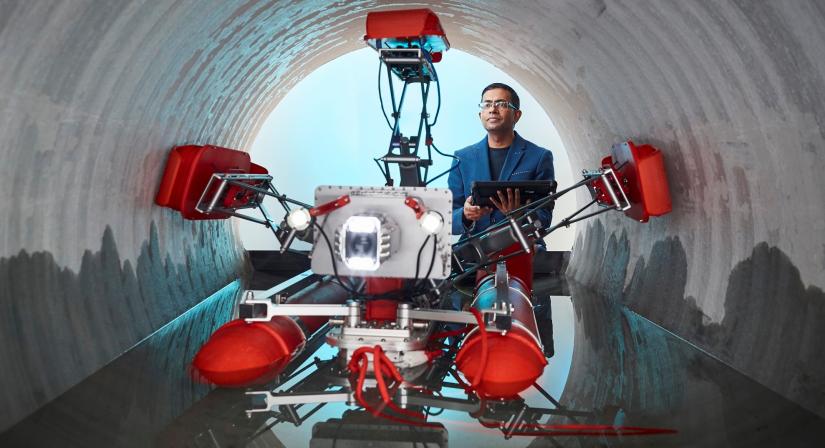Concrete corrosion in sewers is a significant global challenge. Due to ageing infrastructure, and increasing sewage temperatures (caused by urbanisation), the risk of pipes failing is increasing year on year. This poses substantial risks to utility operations, public health and the environment.
One utility company well aware of the issue is Sydney Water, who are responsible for maintaining 500km of large concrete wastewater pipes and 23,000km of smaller concrete pipes. Sydney Water’s annual expenditure to maintain and rehabilitate their wastewater assets is in the region of $40 million but, thanks to the robotics team at UTS, these costs may soon be trending down.
UTS Robotics Institute has been working with Sydney Water since 2013 to investigate and provide solutions for the problem of sewer pipe concrete corrosion.
“Our idea, which is well-advanced and attracting international attention, has been to build specialised robots and send them underground to undertake the dirty work,” explains Professor Sarath Kodagoda, Acting Director of UTS Robotics Institute.
Currently, the larger water pipes are physically traversed by humans checking for damage and taking away samples for testing, which is not only disruptive to services, time consuming and logistically challenging, but also dangerous. The smaller pipes are generally assessed using CCTV, which isn’t all that accurate because it relies on subjective observation.
The technology provides crucial data, informs timely decisions that save money on renewal costs, helps protect the environment and improves human health and safety.
Professor Sarath Kodagoda
“Equipped with a ground penetrating radar, pulse eddy current technology-based sensors and laser profiling technology, our sewer pipe robot, which we call CRAFT (Corrosion and Rebar Assessment Floating Tool), can be deployed underground at any point throughout the system. It’s a floating device operated through a remote-control station, which means operators can identify corrosion levels and other defects in concrete sewer pipes in real time,” says Kodagoda.
CRAFT can enter concrete sewers through a 650mm diameter manhole, and expand to fit a maximum 1.5m diameter pipe, allowing for safe and remote inspection in confined spaces. A laser camera reconstructs the full colour, three-dimensional internal structure of the sewer, which can act as a screening tool to determine suspicious areas that need more attention and measurements.
Completely non-destructive, once fully operational CRAFT will reduce maintenance costs, improve accuracy, negate the need to send humans underground, and reduce the likelihood of catastrophic pipe failures.
“The technology provides crucial data, informs timely decisions that save money on renewal costs, helps protect the environment and improves human health and safety,” Kodagoda continues.
“It has the potential to completely revolutionise how concrete water pipe and wastewater infrastructure is inspected, in Australia and overseas."
Having built a fully functional prototype, the team will continue to work closely with Sydney Water to deploy and refine it over the next couple of years while simultaneously developing a commercialisation pathway. They are hoping for broad service availability by mid-2024.
“Once operationalised, we estimate the technology will save Sydney Water $2 million per year in maintenance costs and, with timely renewals, more than $5 million per year in structural renewal costs,” Kodagoda says.
“This project will help Sydney Water continue to provide high-quality services to its five million customers while minimising disruptions.”
Dammika Vitanage, Asset Infrastructure Research Coordinator, Corporate Strategy at Sydney Water is highly complimentary about the team’s work. “They are very easy to work. The outcomes of the joint collaboration demonstrate our success.”
The research has not only won several prestigious prizes, but has caught global attention with the research being used to underpin a number of other fascinating projects.
Research team
-
Acting Director, UTS Robotics, Faculty of Engineering and Information Technology
-
Director, UTS Robotics and Distinguished Professor, School of Mechanical and Mechatronic Engineering



